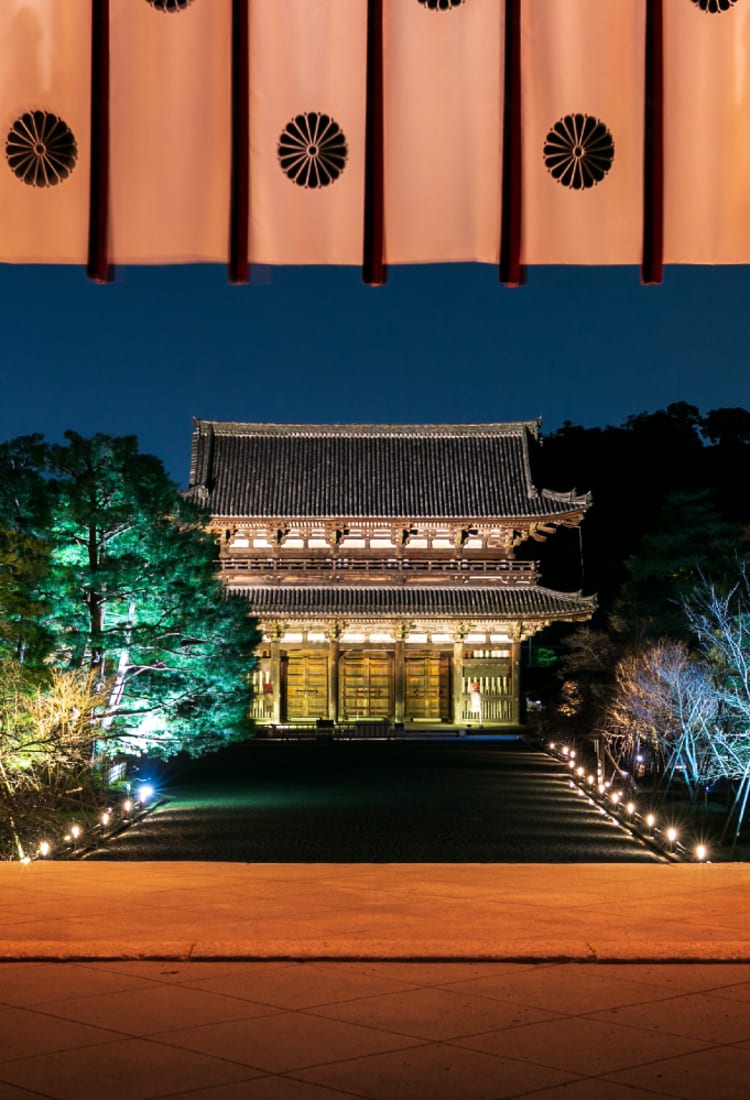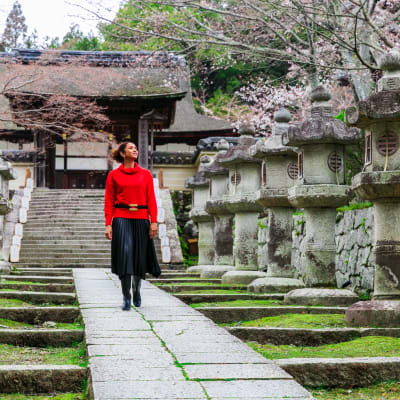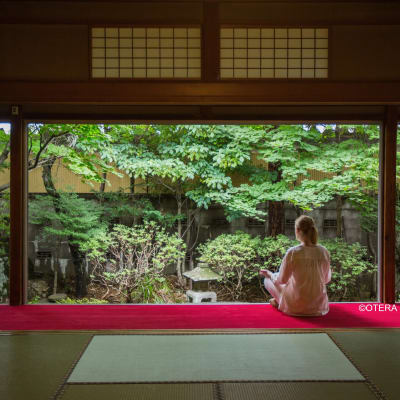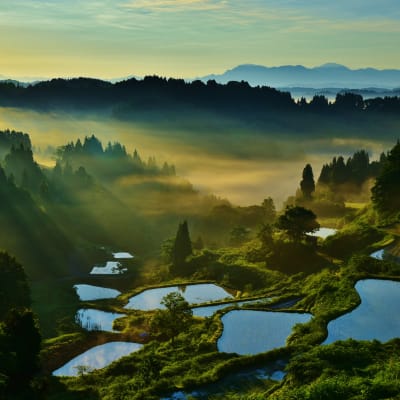
Temple Stays Ninna-ji Temple Exclusive Use of an Ancient Temple in Kyoto
Enjoy the royal treatment in Kyoto, staying at the World Heritage Ninna-ji Temple
As the heavy wooden doors of the Niomon gate slowly swing open to reveal a serene oasis of ancient structures and beautiful gardens, it is clear that a stay at Ninna-ji Temple will be like no other. The grounds, temples, and cultural treasures are available for your private enjoyment after the temple complex closes to the public in the late afternoon.

Guests enter the temple grounds through the huge Niomon gate, guarded by Nio warrior figures.
©Ninna-ji Temple
Ninna-ji Temple is a vast complex spread across 80 hectares in Omuro, northern Kyoto. The temple was founded in 888 and has a deep connection with the imperial family, whose members served as head priests for many generations. Ninna-ji Temple is part of the Historic Monuments of Ancient Kyoto UNESCO World Heritage Site.

Enjoy views of the gardens and five-storied pagoda from the former head priests' residence.
©Ninna-ji Temple
The temple offers a one-of-a-kind experience, welcoming a maximum of five guests at a time to stay for a night and have the run of the entire temple complex. Funds from the stay are directed back to preserving the temple and other cultural properties across Japan.
Experience the rich culture and heritage of Kyoto, from ancient temples to contemporary art; explore the natural beauty of Arashiyama or dine in a historical riverside villa. Through a stay at Ninna-ji Temple, you can discover your very own Kyoto.
A temple with imperial roots
Ninna-ji Temple was founded during the Heian period (794–1185), one of the great flowerings of culture, art and literature. It is one of only a handful of temples including Daikakuji in Kyoto and Rin-no-ji in Nikko, in which members of the imperial family served as head priests. Emperor Uda (867–931), Japan’s 59th emperor and the founder of Ninna-ji, abdicated in favor of his eldest son in 897, then retired to Ninna-ji and took the tonsure in 899. He became the head priest of Ninna-ji Temple, which came to be known as Omuro Imperial Palace. This began a tradition of imperial princes serving as head priests at Ninna-ji which continued for around 30 generations.

A musician plays a sho, a traditional wind instrument, in the shinden hall of Ninna-ji Temple.
©Ninna-ji Temple
The elegant Goten is the former residence of the head priests. The painted panels, intricately carved wooden transoms, formal gardens and covered walkways are a reminder of Ninna-ji’s imperial connections. In the evening, gazing across the moonlit gardens, entertained by traditional court music, it might feel like you have slipped back in time.
A bespoke experience
A stay at Ninna-ji Temple begins long before guests arrive. Temple staff consult with guests to arrange a tailored program of experiences and determine their food preferences and cultural interests in preparation for their stay. Guests stay at Shorin-an, a private villa on the temple grounds, which is carefully prepared with a curated selection of cultural treasures, seasonal flowers and even furniture chosen specifically for each party.
Guests are welcomed through the Niomon gate after the temple grounds are closed to the public at 4.30 p.m. Stroll through the grounds to Shorin-an to relax and discuss the evening’s activities, followed by a private tour of the grounds with one of the temple’s priests to see Ninna-ji’s cultural treasures (an interpreter can be arranged). This is an opportunity to see many of the temple’s National Treasures and Important Cultural Properties, which are usually not displayed for the public.

Guests of Ninna-ji can enjoy a private tour of the five-storied pagoda.

See the temple’s sacred texts in the kyozo (sutra repository).
Guests can walk inside the kondo (main hall), see 400-year-old wall paintings inside the five-storied pagoda, and visit the kyozo (sutra repository), a storehouse for the temple’s sacred texts. By the time the leisurely tour has finished, the grounds are illuminated, creating a magical atmosphere.
Most of the buildings within the temple grounds date from the Edo period (1603–1867). They were rebuilt after they were destroyed during the Onin War (1467–1477), a civil war sparked by a succession dispute within the shogun's family, that devastated much of Kyoto.

At night, guests of the temple have the illuminated grounds to themselves.

The kondo (main hall), illuminated at night
A taste of temple life
The evening meal is served in the shinden hall, at the center of the palatial former head priests’ residence. During the Heian period (794–1185), the residence became a salon for poets, artists and the nobility to gather. The residence was reconstructed in 1914, with wide verandas and covered walkways. The shinden, bathed in soft golden light and paneled with painted scenes of nature and courtly life, takes visitors back to ancient times.

Enjoy an evening meal in the palatial shinden hall, with optional cultural experiences, including ikebana and traditional music.
©Ninna-ji Temple
Guests sit at low tables on the tatami floor to enjoy the meal and the evening’s entertainment, much as the nobility might have done a thousand years ago. Meals can be selected before the stay, including traditional vegetarian temple dishes (shojin ryori), or elegant Kyoto-style kaiseki dishes. Guests have a choice of traditional entertainments including gagaku (courtly music), an ikebana demonstration, or a performance of Noh theater. Kyoto’s famous maiko and geisha can be invited to perform music and dance. On nights when the moon is full, guests can opt for moon viewing accompanied by prayers, chanted by a group of priests.
Sleep like a samurai
Retire for the evening to Shorin-an, a secluded private villa on the grounds. It was the home of the Hisatomi family, a samurai family who served at Ninna-ji. While the temple priests took care of spiritual matters, samurai who served the temple handled its management and protection. Generations of the Hisatomi family served Ninna-ji from the fifteenth century and later bequeathed the home to the temple.

Stay at Shorin-an, a comfortable private villa on the temple grounds.
©Ninna-ji Temple
The villa has been renovated in a mix of traditional and contemporary Japanese styles and has its own traditional tearoom and private gardens. The accommodations are simple but comfortable, with raised futon beds and lofty duvets, locally crafted furnishings, a modern bathroom, air conditioning and Wi-Fi. The villa will be prepared before your arrival with historical objects and treasures from the temple collection. In the morning, guests can join morning prayers, before breakfast in the shinden hall.
A short pilgrimage on hallowed grounds
Before leaving Ninna-ji Temple, make time for the Omuro Pilgrimage, a hiking course in the hills behind Ninna-ji. The course is based on Shikoku’s famous Henro pilgrimage of 88 temples, one of the world’s few circular pilgrim routes. The original takes several months to walk the 1,200-kilometer route around the island of Shikoku. In 1827, the 29th head priest of Ninna-ji had a dream of bringing a more manageable version of the pilgrimage to Kyoto. He sent a representative to Shikoku to bring back a sample of earth from each of the temples. A course of 88 small temples was constructed in the hills behind Ninna-ji, with earth from each Shikoku temple used to sanctify the ground of each corresponding new temple. The Omuro pilgrimage takes two to three hours to complete. The trail has some steep sections and steps, but it is not particularly challenging.


The Omuro pilgrimage trail of 88 small temples is a manageable version of the Shikoku Henro pilgrimage.
©Ninna-ji Temple
Kyoto’s cutting-edge museum
The Kyoto City KYOCERA Museum of Art opened in 2020 as a major renovation of the Kyoto Municipal Museum of Art—a Kyoto landmark, built in 1933. The innovative concepts of architects Jun Aoki and Tezzo Nishizawa for the renewal project fused original and new elements to create a fresh image for the museum.
The museum faces Okazaki Park in the Higashiyama district of Kyoto, close to Heian Jingu Shrine. The museum collection of modern and contemporary art comprises around 3,700 works, most with a connection to Kyoto. At Enfuse, the stylish on-site cafe, visitors can enjoy simple meals, coffee, sweets, and craft beers, from Kyoto-based producers. The cafe staff can prepare a seasonal picnic basket for a leisurely lunch in the museum grounds or the nearby park.

The Kyoto City KYOCERA Museum of Art houses a collection of modern and contemporary art.
Photo: Koroda Takeru
Escape to Arashiyama
Arashiyama in western Kyoto has been a place of relaxation for thousands of years, with lush bamboo groves and a landscape that inspires poetry. This beautiful area along the Katsura River is a 15-minute drive from Ninna-ji Temple. Arashiyama became popular during the Heian period (794–1185), when Emperor Go-Saga (1220–1272), Japan’s 88th emperor, retired to the area, bringing cherry blossoms from Mt. Yoshino in Nara.

Stroll the lush Arashiyama Bamboo Grove.
The Arashiyama Bamboo Grove lines a 400 meter-long path that runs between Nomiya Shrine and Okochi-Sanso Villa. Follow the path uphill towards the Okochi-Sanso Villa. From the villa, you can walk through Arashiyama Park to Shoraian, a beautiful restaurant perched above the Katsura River. The restaurant was once a holiday villa, constructed around 130 years ago in rustic sukiya-zukuri style, with features inspired by the design of Katsura Rikyu, a holiday villa built for the imperial family in 1645.
The menu at the elegant, relaxed restaurant changes each month to match the seasons, but there is always a focus on freshly made tofu and Kyoto vegetables. The tofu comes from Saga Tofu Morika, a company that has been making tofu in Arashiyama for 150 years. The rooms are simply decorated with seasonal flowers and artworks by the restaurant owner, Fuyo Kobayashi, who is an artist and calligrapher. Dining on Kyoto delicacies, serenaded by the sounds of the river below, it is easy to understand why Arashiyama has drawn visitors for centuries.

Enjoy lunch at Shoraian, a beautiful restaurant with views over the Katsura River.

A kaiseki meal at Shoraian consists of seasonal dishes using local ingredients, including fresh tofu.
A soothing soak
Arashiyu, a foot spa near the entrance to Arashiyama Bamboo Grove, takes the traditional ashiyu foot bath and adds an elegant twist. Relax after a day of strolling, with a foot and leg massage and a soak in a foot bath with seasonal flowers or green tea. All treatments include a cup of Kyoto’s famous green tea (or coffee if you prefer). The spa also offers a kimono rental and dressing service and can organize a rickshaw to take you around the sites of Arashiyama in style.
Adventure in the skies
Take to the skies for a bird’s eye view of Kyoto and its many temples. For those looking for a thrilling experience, Birds Paraglider School offers tandem and solo paragliding experiences high in the hills around northwestern Kyoto. The school has two purpose-built areas for paragliding. There is a practice area with a wide and gentle slope designed for practicing solo flights, and a separate take-off point for flights at Para-Park Kyoto on Mt. Saburougatake, with an elevation of 580 meters. The area has gentle thermal updrafts and a clear landing area. If you are lucky, you may experience gliding above the unkai or “sea of clouds,” a phenomenon that tends to occur in the mornings, when a layer of cool air is trapped under a layer of warm air.

Try a tandem paragliding experience for a thrilling view of Kyoto from the air.

When the weather conditions are right, gliders can drift over a sea of clouds.
Measures against the spread of COVID-19
Ninna-ji Temple is only available to one group at a time. Accommodations and meals are served in a private environment. All areas of the temple and accommodation are regularly disinfected and ventilated.


























































